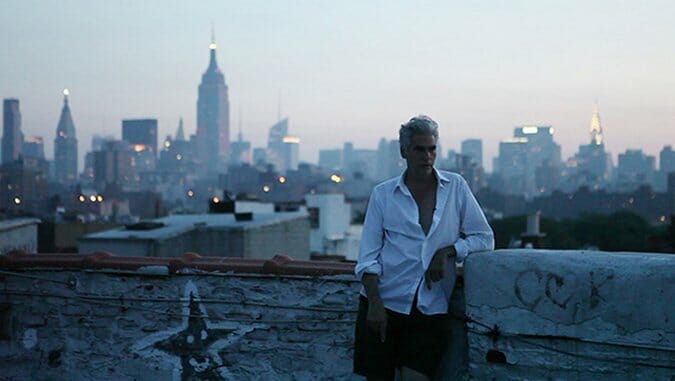
Nonfiction films don’t have to be explicitly character-driven, of course, but director Thomas Wirthensohn’s Homme Less is most definitely that, and it benefits from having as its subject a figure who possesses the holy trinity of traits that most documentarians would desire in any interviewee: candor, introspectiveness and the ability to articulate their feelings and desires. A premiere at the Kitzbuehel Film Festival and the Grand Jury Prize winner at this year’s DOC NYC, the deceptively unadorned Homme Less is an affecting, thought-provoking look at a middle-aged indigent man who belies conventional notions of what modern American homelessness looks like.
The film centers on Mark Reay, a 52-year-old New York City fashion photographer and former model who quotes Joseph Campbell and seems fairly self-aware. Fit and possessing a stylish salt-and-pepper haircut (Reay more than passingly resembles an older Montgomery Clift or Rock Hudson, as someone points out late in the movie), Reay subsists on his glamour photography hustle, occasional royalty checks for a handful of past acting appearances, and sporadic day-player work on films and TV shows. He has friends and health insurance (through the Screen Actors Guild, for which Reay says he pays around $280 per month), as well as a gym membership at the YMCA, whose lockers serve as his de facto storage unit. He also sleeps under a tarp in a hideaway nook on the roof of a building across from a friend’s apartment (unbeknownst to said friend).
The exact conditions informing Reay’s vagrancy remain somewhat cloudy (he talks about living in Chelsea much earlier, in the 1990s, and then getting a $30,000 check to move out of an apartment for which he was paying $300 per month), but it’s clear that economic considerations factor heavily into his circumstances. He seems not to have enough money—and specifically regular income—to make monthly rent payments. But could Reay, certainly no idiot, get another job to supplement his freelance photography work? Probably, it seems. But what would then become of his dreams?
Describing his life as one of “great adventures but no real achievements,” Reay oscillates between contentedness and a more understandable anxiousness and depression over his situation. “I really don’t mind it,” he insists early in the movie. “It’s odd, but I feel like a survivor.” Later, after mentioning his inability to ever tell anyone outside of his nuclear family that he loves them, he comes to a darker conclusion, almost whispering, “I’m on the wrong path.” It’s a credit to the movie that both statements feel equally true in the moment.
Slim and smartly edited, Homme Less takes advantage of Reay’s personable nature to introduce his homelessness as a twist of sorts, and almost incidental to his life, more than 15 minutes into the movie. Taking the French term for “man,” its title is an obvious play on words—but it’s no lazy pun. The Austrian-born Wirthensohn invests in his film a nice balance of pathos and reflection that elicits in the viewer a mannered consideration of the psychologically diminishing effects of homelessness, as when Reay talks about being so removed from any sort of normal dating life that the very idea that sex could involve anyone else is foreign to him.
Abetting this ruminative tone is a score, by Kyle Eastwood and Matt McGuire, that is a pleasant, simple modern jazz riff with a wistfully evocative leitmotif. And it fits Homme Less perfectly. If there’s a shortcoming, it’s that the movie doesn’t feel like it digs down quite deeply enough into Reay’s creative connection to photography. For someone ostensibly pursuing their bliss to punishing ends, his passion is peculiarly bottled up. Reay seems more just defeated by life.
Still, that’s part of what makes the film so haunting—there’s a betterment for him just out of reach. Reay is so compelling in his own melancholic way that Homme Less could easily play on a nonfiction/narrative feature double bill with something like James Mangold’s 1996 film Heavy, touching as it does on the same themes of loneliness, depression and squelched hope—romantic and otherwise. As an unfussy yet poignant portrait of life on the margins, there are few other movies like it this year.
Director: Thomas Wirthensohn
Starring: Mark Reay
Release Date: August 7, 2015
Entertainment journalist Brent Simon is Time Magazine’s 2006 Person of the Year and a sworn enemy to auto-play website videos, as well as a member of the Los Angeles Film Critics Association. You can follow him on Twitter.